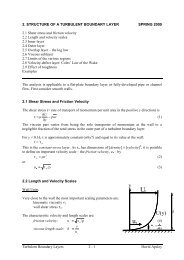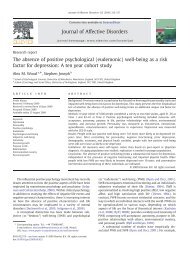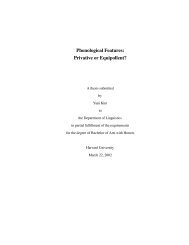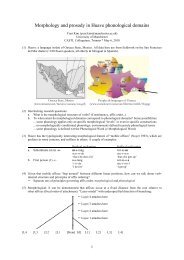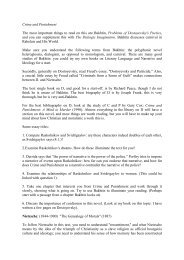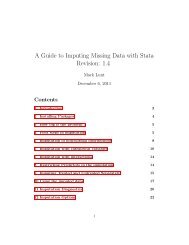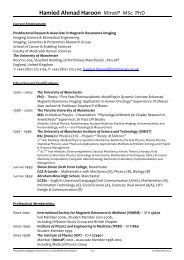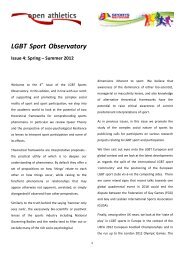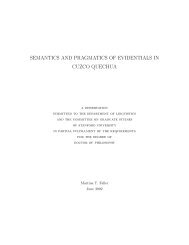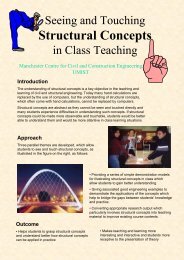Countability and Cantor Sets
Countability and Cantor Sets
Countability and Cantor Sets
You also want an ePaper? Increase the reach of your titles
YUMPU automatically turns print PDFs into web optimized ePapers that Google loves.
MATH31011/MATH41011/MATH61011:<br />
FOURIER ANALYSIS AND LEBESGUE INTEGRATION<br />
Chapter 2: <strong>Countability</strong> <strong>and</strong> <strong>Cantor</strong> <strong>Sets</strong><br />
Countable <strong>and</strong> Uncountable <strong>Sets</strong><br />
The concept of countability will be important in this course <strong>and</strong> we shall revise it here. A<br />
set E is said to be countable if it can be put in one-to-one correspondence with a subset<br />
of N = {1, 2, 3, . . . }. More mathematically, E is countable if there exists a surjection<br />
f : N → E, or E is empty. 1<br />
Such sets are either<br />
(a) finite sets; or<br />
(b) countably infinite sets: these can be put into bijection (one-to-one correspondence)<br />
with N itself.<br />
A simpler way to describe countable sets is that their elements can be written as a sequence:<br />
{x 1 , x 2 , x 3 , . . . }. If the set is finite, this is only a finite sequence (going up to x n , say) but<br />
if the set is infinite, it is an infinite sequence.<br />
If a set is not countable then we say it is uncountable.<br />
Here are some st<strong>and</strong>ard results about countability.<br />
Proposition 2.1.<br />
(i) Let E be a countable set <strong>and</strong> let f : E → F be a surjection. Then F is countable.<br />
(ii) Any subset of a countable set is countable.<br />
Proof. Exercise.<br />
□<br />
Proposition 2.2. Z is countable.<br />
Proof. A bijection between N <strong>and</strong> Z can be defined as follows:<br />
□<br />
1 2 3 4 5<br />
↕ ↕ ↕ ↕ ↕ · · ·<br />
0 1 −1 2 −2<br />
1 In what follows this case should often be treated separately but we neglect to do so since it is trivial. You<br />
can check that everything still works.<br />
1<br />
Typeset by AMS-TEX
Proposition 2.3. If E <strong>and</strong> F are countable then<br />
(i) E ∪ F is countable.<br />
(ii) E × F is countable.<br />
Proof. The cases when one of E, F are empty are trivial. Otherwise there exist surjections<br />
f : N → E <strong>and</strong> g : N → F .<br />
(i) We can define a map h : N → E ∪ F by<br />
{ (<br />
f<br />
n<br />
)<br />
2 if n is even<br />
h(n) =<br />
g ( )<br />
n+1<br />
2 if n is odd,<br />
<strong>and</strong> it is easy to check that this is a surjection from N onto E ∪ F .<br />
(ii) Define h : N × N → E × F by h(m, n) = (f(m), g(n)). Again, it is easy to check that<br />
this is a surjection. So the result reduces to showing that N × N is countable (since then<br />
there is a surjection ϕ : N → N × N, making h ◦ ϕ : N → E × F a surjection).<br />
Using the array<br />
(1, 1) (1, 2) (1, 3) (1, 4) · · ·<br />
(2, 1) (2, 2) (2, 3) (2, 4) · · ·<br />
(3, 1) (3, 2) (3, 3) (3, 4) · · ·<br />
(4, 1) (4, 2) (4, 3) (4, 4) · · ·<br />
.<br />
.<br />
one can construct a bijection ϕ : N → N × N by “diagonal enumeration”: ϕ(1) =<br />
(1, 1), ϕ(2) = (1, 2), ϕ(3) = (2, 1), ϕ(4) = (1, 3), ϕ(5) = (2, 2), ϕ(6) = (3, 1), etc. □<br />
Proposition 2.4. Q is countable.<br />
Proof. Consider the array<br />
.<br />
.<br />
1 2 3 4 · · ·<br />
1 2 3 4<br />
2<br />
2 2<br />
· · ·<br />
1 2 3 4<br />
3 3<br />
3<br />
· · ·<br />
1 2 3 4<br />
4 4 4 4<br />
· · ·<br />
.<br />
.<br />
.<br />
.<br />
. ..<br />
This contains the set Q > of all rational numbers > 0, with some duplications (e.g. 1 =<br />
2<br />
2 = 3 3 = 4 4 = · · · ). Defining a surjection from N onto Q> by the diagonal method as above<br />
shows that Q > is countable. Similarly, Q < is countable so since Q = Q > ∪ Q < ∪ {0}, Q is<br />
countable by Proposition 2.3(i). □<br />
More generally, we have:<br />
Proposition 2.5. If E n is countable, n ∈ N, then E = ∪ ∞<br />
n=1 E n is countable.<br />
Proof. Omitted. 2 □<br />
2 Intuitively, we take a surjection h n : N → E n for each n <strong>and</strong> note that g : N × N → ∪ ∞<br />
n=1 E n defined by<br />
g(n, m) = h n (m) is a surjection. Hence ∪ ∞<br />
n=1 E n is countable by Proposition 2.1, since N × N is countable<br />
by Proposition 2.3. In general the existence of a set of surjections as above can only be guaranteed by<br />
some form of the Axiom of Choice. In this course (in common with most areas of mathematics) we assume<br />
the Axiom of Choice, hence the result.<br />
2<br />
. ..
Proposition 2.6. R is uncountable.<br />
Proof. Every real number can be represented by a decimal expansion. For simplicity, just<br />
consider the numbers in [0, 1). Such a number has an expansion<br />
0.a 1 a 2 a 3 a 4 . . .<br />
where a n ∈ {0, 1, 2, . . . , 9}. Sometimes this expansion is not unique (e.g. 0.1000 . . . =<br />
0.0999 . . . ) but choosing to represent such numbers by the expansion ending in 000...<br />
rather than 999... makes it unique (exercise).<br />
Suppose [0, 1) were countable. Then we could list its elements (i.e., put them into one-toone<br />
correspondence with N):<br />
x 1 = 0.a (1)<br />
1 a(1) 2 a(1) 3 a(1) 4 . . .<br />
x 2 = 0.a (2)<br />
1 a(2) 2 a(2) 3 a(2) 4 . . .<br />
x 3 = 0.a (3)<br />
1 a(3) 2 a(3) 3 a(3) 4 . . .<br />
x 4 = 0.a (4)<br />
1 a(4) 2 a(4) 3 a(4) 4 . . .<br />
.<br />
But it is possible to construct a number y not in this list: define<br />
{<br />
(n) 5 if a n ≠ 5<br />
b n =<br />
6 if a (n)<br />
n = 5 .<br />
Then y = 0.b 1 b 2 b 3 b 4 . . . is not in the above list, since it differs from x n in the nth decimal<br />
place. Therefore [0, 1) is uncountable <strong>and</strong> hence R is uncountable. □<br />
The Middle Third <strong>Cantor</strong> Set<br />
We shall now describe a more complicated subset of R which is uncountable. This set is<br />
called the Middle Third <strong>Cantor</strong> set <strong>and</strong> we shall return to it later in the course.<br />
Geometric description. We start with the unit interval<br />
Now define a new set<br />
C 0 = [0, 1].<br />
C 1 = C 0 \(1/3, 2/3) = [0, 1/3] ∪ [2/3, 1],<br />
i.e., we obtain C 1 by deleting the open middle third of C 0 .<br />
Next we obtain a new set C 2 by deleting the open middle thirds of each of the intervals<br />
making up C 1 ,<br />
C 2 = [0, 1/9] ∪ [2/9, 1/3] ∪ [2/3, 7/9] ∪ [8/9, 1].<br />
Continue in this way to obtain sets C n , n ≥ 0, where C n consists of 2 n disjoint closed<br />
intervals of length 3 −n , formed by deleting the middle thirds of the intervals making up<br />
C n−1 .<br />
The Middle Third <strong>Cantor</strong> set is defined to be the intersection of these sets:<br />
∞∩<br />
C = C n .<br />
n=1<br />
3
Arithmetic description. We also have<br />
{<br />
}<br />
∞∑<br />
C = x ∈ [0, 1] : x = a n 3 −n , a n ∈ {0, 2}, for all n ≥ 1 .<br />
n=1<br />
(Since 0 ≤ a n 3 −n ≤ 2 · 3 −n , the series converge.) Hence we might also describe C as the<br />
set of reals with a ternary expansion<br />
such that a n = 0 or 2, for all n ≥ 1.<br />
0.a 1 a 2 . . . a n . . .<br />
Lemma 2.7. Let a n , b n ∈ {0, 2} for n ∈ N <strong>and</strong> let x = ∑ ∞<br />
n=1 a n3 −n , y = ∑ ∞<br />
n=1 b n3 −n .<br />
Suppose there exists at least one m ∈ N such that a m ≠ b m . Then x ≠ y.<br />
Proof. Let M = min{n ∈ N : a n ≠ b n }, so that a n = b n , for n < M. We have<br />
x − y = (a M − b M )3 −M +<br />
Recall that, for α, β ∈ R, |α + β| ≥ |α| − |β|, so<br />
|x − y| ≥ |a M − b M |3 −M −<br />
∣<br />
≥ 2 · 3 −M −<br />
≥ 2 · 3 −M −<br />
∞∑<br />
n=M+1<br />
∞∑<br />
n=M+1<br />
∞∑<br />
n=M+1<br />
∞∑<br />
n=M+1<br />
|a n − b n |3 −n<br />
2 · 3 −n<br />
= 2 · 3 −M − 2 3−(M+1)<br />
1 − 1 3<br />
= 2 · 3 −M − 3 −M = 3 −M > 0.<br />
(a n − b n )3 −n .<br />
(a n − b n )3 −n ∣ ∣∣∣∣<br />
Hence x ≠ y.<br />
□<br />
Corollary 2.8. The formula<br />
∞∑<br />
a n 3 −n ↦→ (a n ) ∞ n=1<br />
n=1<br />
gives a well-defined bijective map between C <strong>and</strong> the set S of all sequences (a n ) ∞ n=1, where<br />
a n ∈ {0, 2}, for all n ∈ N.<br />
Theorem 2.9. The Middle Third <strong>Cantor</strong> set C is uncountable.<br />
Proof. S is clearly in bijection with the set {0, 1} N , which is shown to be uncountable in an<br />
exercise. Thus S is uncountable. From Corollary 2.8, it follows that C is uncountable. □<br />
4
Revision of sup <strong>and</strong> inf.<br />
For ∅ ̸= E ⊂ R, we say that m ∈ R is an upper bound of E if, for all x ∈ E, x ≤ m. We<br />
write U(E) for the set of all upper bounds of E:<br />
U(E) = {m ∈ R : ∀x ∈ E, x ≤ m } .<br />
We say that E is bounded above if U(E) ≠ ∅; if U(E) = ∅ then we say that E is unbounded<br />
above.<br />
Similarly, we say that l ∈ R is a lower bound of E if, for all x ∈ E, x ≥ l <strong>and</strong> define L(E)<br />
to be the set of all lower bounds of E:<br />
L(E) = {l ∈ R : ∀x ∈ E, l ≤ x } .<br />
We say that E is bounded below if L(E) ≠ ∅; if L(E) = ∅ then we say that E is unbounded<br />
below.<br />
The real numbers R have the following completeness property:<br />
(1) if ∅ ̸= E ⊂ R, with E bounded above, then U(E) contains a smallest member, i.e.,<br />
there exists m ∈ U(E) such that, for all y ∈ U(E), m ≤ y. We write m = sup E<br />
(or sometimes l.u.b. E);<br />
(2) if ∅ ≠ E ⊂ R, with E bounded below, then L(E) contains a greatest member, i.e.,<br />
there exists l ∈ L(E) such that, for all y ∈ L(E), y ≤ l. We write l = inf E (or<br />
sometimes g.l.b. E).<br />
If E is unbounded above then we write sup E = +∞ <strong>and</strong> if E is unbounded below then<br />
we write inf E = −∞.<br />
Proposition 2.10. Let E ⊂ R be bounded above. Then<br />
m = sup E<br />
⇐⇒<br />
{ m ∈ U(E), <strong>and</strong><br />
∀ϵ > 0 ∃x ∈ E such that m − ϵ < x.<br />
Proof. Exercise.<br />
□<br />
Proposition 2.11. Let E ⊂ R be bounded below. Then<br />
l = inf E<br />
⇐⇒<br />
{ l ∈ L(E), <strong>and</strong><br />
∀ϵ > 0 ∃x ∈ E such that x < l + ϵ.<br />
Proof. Exercise.<br />
□<br />
Proposition 2.12. Suppose that ∅ ≠ E ⊂ F ⊂ R. Then sup E ≤ sup F <strong>and</strong> inf F ≤ inf E.<br />
Proof. We shall prove the inequality for sup; the argument for inf is similar. If F is<br />
unbounded above then the inequality is obvious, so we assume that F is bounded above<br />
(so U(F ) ≠ ∅). Let m ∈ U(F ), then, for all f ∈ F , f ≤ m. Hence, for all e ∈ E, e ≤ m,<br />
i.e., m ∈ U(E). So U(F ) ⊂ U(E). In particular, the smallest element of U(E) is ≤ the<br />
smallest element of U(F ), i.e., sup E ≤ sup F . □<br />
5
Limsup <strong>and</strong> Liminf<br />
Let x n , n ≥ 1, be a sequence of real numbers: this may or may not converge. However,<br />
even if it does not converge we may still define two useful limiting quantities.<br />
Example Consider the sequence<br />
(<br />
x n = (−1) n 1 − 1 )<br />
.<br />
n<br />
The first few values are<br />
0, 1 2 , −2 3 , 3 4 , −4 5 , . . . .<br />
Clearly, this sequence does not converge but there is an obvious sense in which 1 is a<br />
“limiting upper bound” <strong>and</strong> −1 is a “limiting lower bound”. We want to make this idea<br />
precise.<br />
But first another example.<br />
Example Consider the sequence<br />
(<br />
x n = (−1) n 1 + 1 )<br />
.<br />
n<br />
The first few values are<br />
−2, 3 2 , −4 3 , 5 4 , −6 5 , . . . .<br />
Again, it is clear that this sequence does not converge. This time 1 <strong>and</strong> −1 are not upper<br />
<strong>and</strong> lower bounds but there is still a sense in which they represent greatest <strong>and</strong> least<br />
limiting values.<br />
Definition Given a sequence x n of real numbers, we say that<br />
(with x ∈ R) if, given ϵ > 0,<br />
(i) there exists N ∈ N such that<br />
lim sup x n = x<br />
n→+∞<br />
x n < x + ϵ for all n ≥ N;<br />
(ii)<br />
<strong>and</strong><br />
x n > x − ϵ for infinitely many values of n ≥ 1.<br />
6
We say that<br />
if, given any M ≥ 1,<br />
lim sup x n = +∞<br />
n→+∞<br />
x n > M for infinitely many values of n ≥ 1.<br />
We say that<br />
lim sup x n = −∞<br />
n→+∞<br />
if, lim n→∞ x n = −∞, that is, given any M ≥ 1, there is N ∈ N<br />
Lemma 2.13. We have<br />
x n < −M for all n ≥ N.<br />
lim sup x n =<br />
n→+∞<br />
lim sup x k .<br />
n→+∞<br />
In particular, the lim sup of a sequence of real numbers always exists (though it may be<br />
±∞).<br />
Proof. Exercise.<br />
□<br />
k≥n<br />
Definition Given a sequence x n of real numbers, we say that<br />
(with x ∈ R) if given ϵ > 0,<br />
(i) there exists N ≥ 1 such that<br />
(ii)<br />
<strong>and</strong><br />
We say that<br />
if, given any M ≥ 1,<br />
lim inf x n = x<br />
n→+∞<br />
x n > x − ϵ for all n ≥ N;<br />
x n < x + ϵ for infinitely many values of n ≥ 1.<br />
lim inf x n = −∞<br />
n→+∞<br />
x n < −M for infinitely many values of n ≥ 1.<br />
We say that<br />
lim inf x n = ∞<br />
n→+∞<br />
if lim n→∞ x n = ∞, that is, given any M ≥ 1, there is N ∈ N<br />
Lemma 2.14. We have<br />
x n > M for all n ≥ N.<br />
lim inf x n = lim inf x k.<br />
n→+∞ n→+∞ k≥n<br />
In particular, the lim inf of a sequence of real numbers always exists (though it may be<br />
±∞).<br />
Proof. Exercise.<br />
□<br />
7





